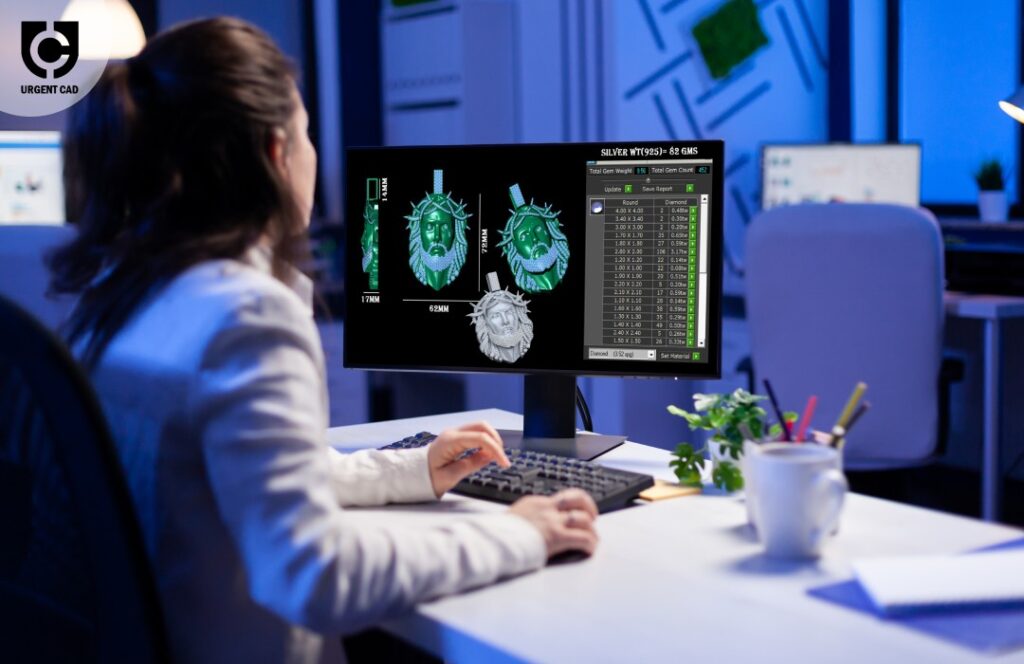
Jewellery is no longer just handcrafted in dimly lit studios—today, it’s designed with pixel-perfect precision. The secret behind this transformation? CAD (Computer-Aided Design). In the fast-paced world of jewellery design, CAD has become the silent hero, turning dreams into digital blueprints and finally, into stunning wearable art.
Let’s dive into how CAD has reshaped the jewellery industry, what it means for designers and clients, and why this technology is here to stay.
What is CAD?
CAD, or Computer-Aided Design, is the use of software to create detailed 2D or 3D digital models. In jewellery, CAD allows designers to build precise virtual prototypes of rings, pendants, earrings, and more, before a single piece of metal or gemstone is touched.
Unlike traditional sketching, CAD models are highly accurate and easily modifiable, which streamlines everything from prototyping to production.
The Rise of CAD in Jewellery Design
Jewellery design was once entirely manual—carved wax models, hand-drawn sketches, and trial-and-error craftsmanship. But with the advent of CAD in the late 20th century, the landscape began to shift. By the early 2000s, CAD tools became widely accessible, and today, they are a mainstay in every modern jewellery workshop.
Why Jewellery Designers Embraced CAD?
- Precision: CAD ensures perfect symmetry, accurate measurements, and exact stone placements.
- Speed: Designers can create, adjust, and finalize models quickly, often within hours.
- Creativity: Complex patterns, intricate textures, and unique structures that were once impossible are now achievable.
- Client Visualization: Clients can see realistic renders of their jewellery before it’s even made.
How CAD Works in the Jewellery Industry?
1. Conceptualization and Sketching
It all starts with an idea. Whether inspired by nature, architecture, or emotion, designers first conceptualize the look and feel of a piece. CAD Price allows that concept to be built digitally, with full control over scale, dimensions, and form.
2. 3D Modelling
Using software like RhinoGold, MatrixGold, or ZBrush, jewellery CAD artists develop a 3D model of the design. Every curve, prong, and setting is crafted virtually, ensuring total accuracy.
3. Rendering
High-resolution renders give clients a lifelike preview of the final product. These images mimic the reflection of metals, the brilliance of diamonds, and the play of light, boosting customer confidence and satisfaction.
4. Prototyping
Once the design is approved, it’s exported to CAM (Computer-Aided Manufacturing) tools or 3D printers. A wax or resin prototype is created for casting, minimizing material waste and production errors.
5. Final Manufacturing
After casting and polishing, the piece is set with stones and finished by hand. But thanks to CAD, this process is faster, more efficient, and highly consistent.
Benefits of CAD for Jewellery Designers
➡️Enhanced Design Accuracy
With CAD, there’s no guesswork. Dimensions are precise, alignment is perfect, and tolerance issues are eliminated. This is especially critical for custom engagement rings and high-value pieces.
➡️Improved Client Collaboration
Clients can review renders, request changes, and see exactly how the final piece will look. Jewellery CAD rendering services promotes a transparent and collaborative design process.
➡️Time and Cost Efficiency
Design iterations that once took days can now be done in minutes. Fewer physical prototypes mean less material waste and lower costs.
➡️Greater Creative Freedom
CAD empowers designers to experiment with textures, forms, and structures that would be challenging or impossible by hand. From geometric statement pieces to filigree vintage styles, the possibilities are limitless.
CAD Software Commonly Used in Design
- RhinoGold: Ideal for precision modelling and stone settings
- MatrixGold: Advanced tools tailored for jewellery creators
- ZBrush: Great for organic shapes and artistic textures
- JewelCAD: User-friendly interface for 3D design
- Blender: Open-source and great for renders & animation
Challenges in Using CAD
Despite its advantages, CAD isn’t without challenges:
- Learning Curve: Mastering CAD software takes time and training.
- Initial Cost: Software licenses and compatible hardware can be expensive.
- Over-Reliance: Some argue CAD reduces the handcrafted essence of jewelry. However, many modern jewellers blend both skills.
The Future of CAD in the Jewellery Industry
The future is bright and digital. As technology advances, AI-powered CAD tools, virtual reality (VR) jewelry try-ons, and parametric design automation are becoming industry norms.
Sustainability is another growing trend—CAD reduces waste, supports digital-only product samples, and enables eco-friendly production workflows.
Final Words:
In the jewellery industry, CAD isn’t just a tool—it’s a transformation. It empowers designers, excites customers, and elevates the art of UrgentCAD to a new level of precision and possibility.
Whether you’re a jeweller looking to modernize your workflow or a customer dreaming of a custom piece, CAD opens the door to imagination with digital confidence.
Our custom jewelry design services are powered by state-of-the-art CAD technology. Let’s turn your vision into a breathtaking reality—designed to perfection, crafted with passion.
FAQs
1. What does CAD mean in jewellery?
CAD stands for Computer-Aided Design, a digital process used to create precise 3D models of jewellery before it is manufactured.
2. Is CAD necessary for all jewellery designers?
While not mandatory, CAD has become a crucial tool for modern jewelry designers who want accuracy, speed, and customization.
3. How much does jewellery CAD software cost?
Prices vary. Some software, like Blender, is free, while professional programs like MatrixGold can cost several thousand dollars annually.
4. Can I make custom jewellery with CAD?
Absolutely. CAD is perfect for custom jewellery—it allows designers to visualize, tweak, and perfect a design before it’s made.
5. Does CAD replace handcrafting in jewellery?
No. Many jewellers use CAD for modelling and still finish pieces by hand. It’s a blend of tradition and technology.
6. How long does it take to design jewelry using CAD?
A simple design might take a few hours, while intricate custom pieces could require several days of digital modelling and revisions.
7. What’s the difference between CAD and CAM in jewellery?
CAD is for design; CAM (Computer-Aided Manufacturing) is for production. Together, they create a seamless design-to-manufacture workflow.


